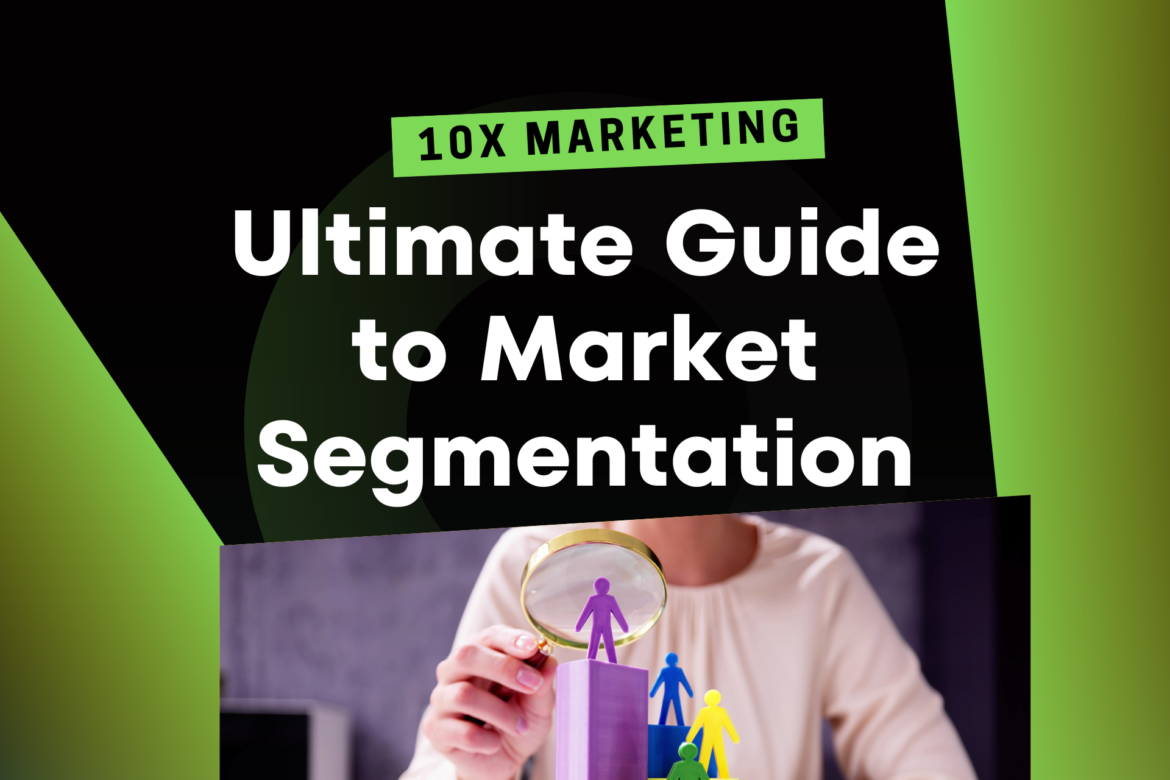The Ultimate Guide To Market Segmentation: will show you how to target your ideal customers, craft messaging that resonates, and create campaigns that drive results.
So, you’ll be able to:
- Increase your marketing ROI
- Boost your conversion rates
- Build stronger relationships with your customers
- Grow your business
Why Psychographics Matter: Unlocking Deeper Customer Insights
Psychographics go beyond basic statistics, delving into the values, interests, lifestyles, opinions, and aspirations of your target audience. It’s about understanding what motivates them, what they care about, and how they navigate the world. By uncovering these psychological and behavioral traits, you gain invaluable insights that can transform your marketing efforts.
Benefits of Psychographic Segmentation:
- Hyper-targeted marketing: Craft messages that resonate on a deeper level, speaking directly to the values and aspirations of specific customer segments.
- Increased engagement: Create content and experiences that pique genuine interest and encourage interaction.
- Boosted conversion rates: Understand what truly drives purchase decisions and tailor your offerings accordingly.
- Stronger brand loyalty: Build deeper connections with customers by aligning your brand values with theirs.
- Improved ROI: Optimize your marketing spend by reaching the right people with the right message at the right time.
Power of Psychographics:
So, how do you tap into the power of psychographics? Here are some key strategies:
- Conduct surveys and polls: Gather data directly from your target audience about their interests, values, and purchasing habits.
- Analyze social media activity: Look at the pages, groups, and hashtags your target audience follows to understand their passions and preferences.
- Leverage customer feedback: Pay attention to reviews, comments, and complaints to gain insights into their motivations and pain points.
- Partner with market research firms: Access specialized data and analysis to gain a deeper understanding of your target market.
By leveraging psychographics, you can move beyond basic demographics and unlock a deeper level of customer understanding. This, in turn, empowers you to craft marketing strategies that truly resonate, driving engagement, loyalty, and ultimately, business growth
What is an example of psychographics?
Ever wondered why your perfectly crafted ad falls flat while a seemingly ordinary campaign goes viral? It’s all about understanding the “why” behind the “what” – the invisible motivations that drive consumer behavior. This is where psychographics step in, offering a powerful lens to delve deep into your audience’s values, interests, and lifestyles.
But beyond the buzzword, what does it mean? Let’s bring it to life with a relatable example:
Picture This: Imagine two individuals, Sarah and David, both browsing for new sneakers. Demographics might paint them as similar – professionals in their 30s. However, their psychographics reveal a different story.
- Sarah: Values sustainability and ethical sourcing. Enjoys outdoor activities and prioritizes comfortable, functional shoes. Seeks brands that align with her eco-conscious values.
- David: Prioritizes style and brand recognition. Enjoys attending social events and seeks trendy, designer sneakers that make a statement. Focuses on brands with high perceived value.
While their age and income align, their psychographic profiles are vastly different. Understanding these nuances makes all the difference.
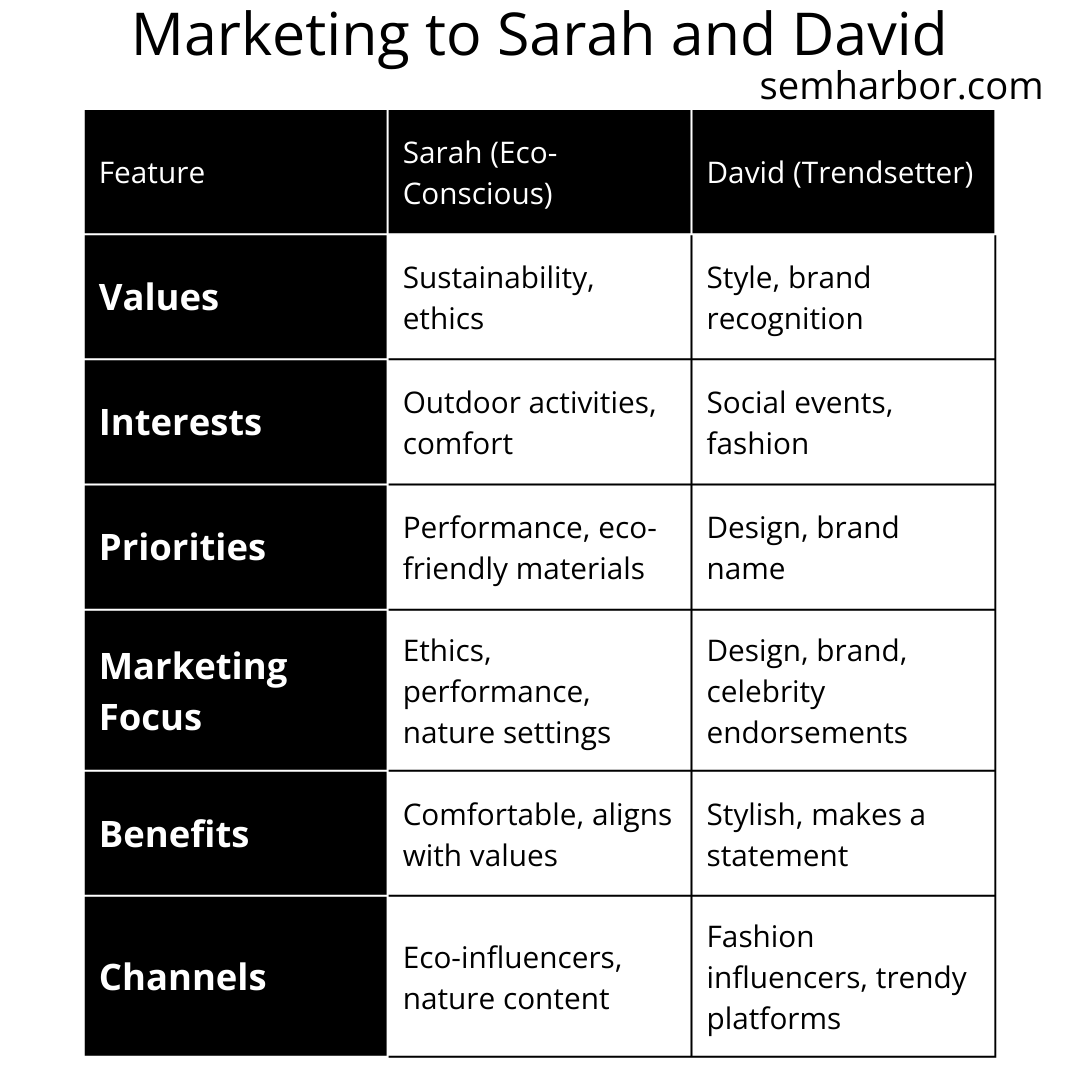
The “Why” Behind the Buy: Reaching the Right Audience with Psychographics
Marketing to Sarah: Focus on the shoes’ eco-friendly materials, ethical manufacturing practices, and performance features. Showcase them in settings like nature trails or parks. Partner with influencers known for their sustainable lifestyle choices.
Marketing to David: Highlight the shoes’ design, brand name, and celebrity endorsements. Showcase them in stylish settings like nightclubs or fashion shows. Partner with influencers known for their trendsetting style.
This is just a glimpse into the power of psychographics. By segmenting your audience based on their “why,” you can:
- Craft targeted messages: Speak directly to their values, interests, and aspirations.
- Develop relevant content: Create engaging experiences that resonate with their lifestyles.
- Choose effective channels: Reach them where they spend their time and attention.
- Boost engagement and conversions: Increase the likelihood of them connecting with your brand.
Remember, psychographics are not about stereotypes or generalizations. They’re about understanding the unique motivations and preferences that drive individual decisions
Psychographics vs Demographics
While demographics paint a picture of who your audience is (age, income, location), psychographics delve into the fascinating realm of why they behave and purchase the way they do.
Imagine the difference: knowing your target audience is 30-40-year-old professionals tell you some things, but understanding their values, interests, and lifestyles paints a far richer picture.
Are they environmentally conscious tech enthusiasts?
Status-driven fashionistas? Family-oriented adventurers?
Psychographics provide these crucial details.
So, let’s dive into the exciting world of psychographics:
What are they?
Psychographics encompasses psychological characteristics, values, attitudes, interests, and lifestyles. They answer questions like:
- What are their hobbies and interests?
- What are their values and beliefs?
- What motivates them?
- What are their preferred media channels?
- What influences their purchasing decisions?
How do they differ from demographics?
Think of demographics as the outer shell: age, income, and education level. Psychographics are the inner workings: motivations, aspirations, and personality traits. While demographics identify groups, psychographics reveal the individuals within them.
Market Segmentation Toolkit
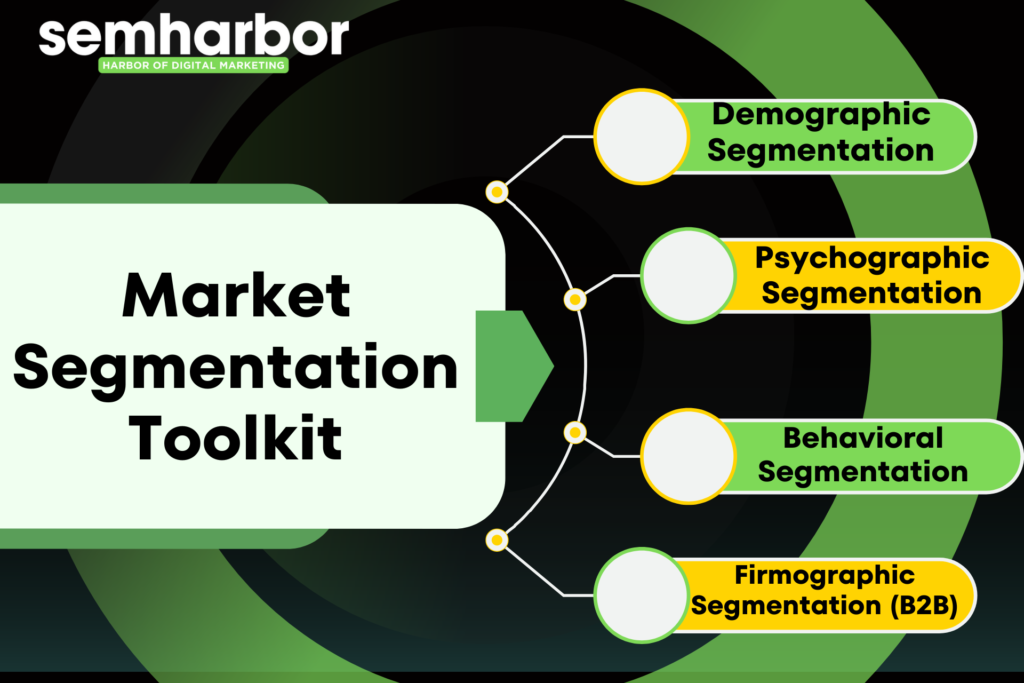
Understand your customers better and target your marketing more effectively with market segmentation.
Demographic Segmentation
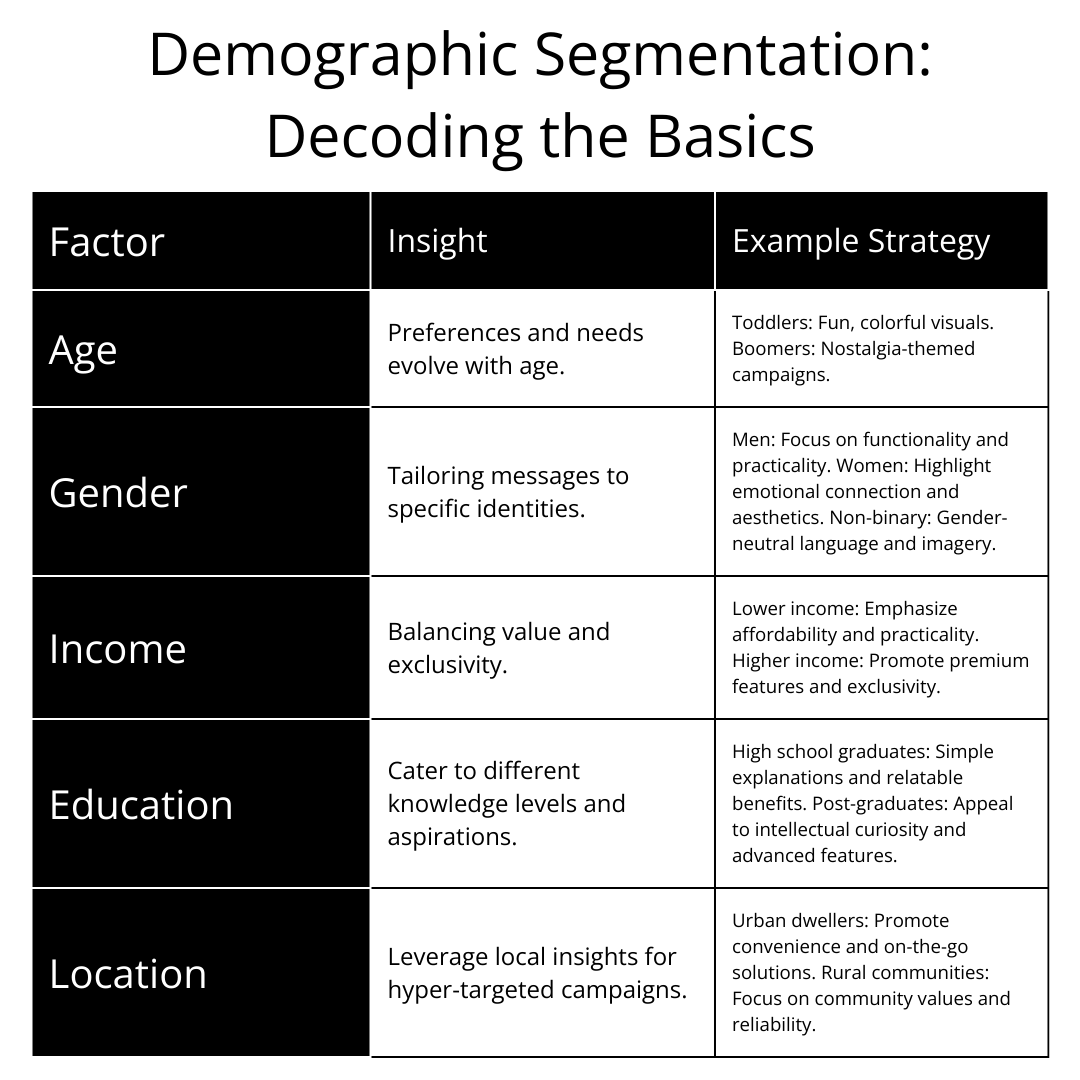
Reach the right people with the right message using demographic segmentation.
Imagine dividing your customer base into distinct groups based on shared characteristics like age, income, education, and location. That’s demographic segmentation in a nutshell. This data-driven approach paints a clear picture of your diverse audience, revealing unique needs, preferences, and behavior patterns within each segment.
Reach the right people with the right message using demographic segmentation.
Toddlers & Their Parents: Nurturing Trust & Engagement
For pre-schoolers, the marketing focus shifts to their parents. Educational apps, toys, and clothing brands can leverage vibrant visuals, playful language, and testimonials from real families. Building trust is paramount, so emphasizing safety, quality, and educational value is key. Partnering with trusted influencers like pediatricians or child development experts further strengthens credibility.
Gen Z: Tech-Savvy & Mission-Driven
This digitally native generation craves authenticity and purpose. Brands that communicate through social media platforms like TikTok and Instagram, using relatable influencers and addressing social issues, resonate deeply. Sustainability, inclusivity, and social justice are important considerations for Gen Z, so aligning brand values with these causes is crucial.
Gen Z Years?
There’s no single, universally accepted birth year range for Gen Z. Different organizations propose slightly different brackets, but most agree they fall somewhere between the mid-1990s to the early 2010s. Here’s a breakdown of some prominent definitions:
- U.S. Census Bureau: 1997-2013
- Pew Research Center: 1997 onwards
- Statistics Canada: 1997-2012
Remember, these are just guidelines, and individual experiences can vary depending on specific birth years and cultural contexts.
Millennials: Balancing Responsibilities & Aspirations
Juggling careers, families, and finances defines this generation. Messaging that acknowledges their busy lives and offers solutions that simplify decision-making is impactful. User-generated content, relatable humor, and personalized recommendations are effective strategies. Brands that cater to their desire for experiences over material possessions will find favor.
While exact dates vary slightly, most experts agree that Millennials were born between 1981 and 1996. This means, as of today (February 20, 2024), they range in age from 28 to 43. This broad age span can contribute to the diverse experiences and characteristics within the group.
Millennials Years
Instead of relying on stereotypes, let’s explore some defining traits of Millennials:
- Tech-Savvy Natives: Growing up alongside the internet and digital technology, Millennials are comfortable navigating the online world and readily adopt new technologies.
- Entrepreneurial Spirit: Fueled by the desire for flexibility and purpose, Millennials are more likely to start their own businesses compared to previous generations.
- Globally Connected: Globalization and social media have fostered a sense of global citizenship in Millennials, making them more aware of and engaged with international issues.
- Socially Conscious: Millennials prioritize social responsibility and ethical practices, favoring brands that align with their values.
- Financially Challenged: Entering adulthood during the Great Recession, many Millennials face student loan debt and a challenging economic landscape, impacting their financial stability.
Gen X: Practical & Value-Conscious
Known for their pragmatism, Gen Xers appreciate straightforward communication and value for money. Focus on product quality, functionality, and long-term benefits. Testimonials from everyday people and transparent pricing resonate well. Humor can be effective, but avoid anything overly trendy or gimmicky.
Baby Boomers: Experienced & Selective
This generation values tradition, quality, and security. Focus on brand heritage, reliability, and the benefits of experience. Nostalgia plays a powerful role, so leveraging classic references and trusted personalities can be effective. Emphasize customer service and build trust by addressing their concerns about privacy and security.
Beyond Demographics: Personalize the Experience
While age is a valuable starting point, remember that individuals within each generation are diverse. Consider layering other segmentation factors like interests, values, and online behavior to create truly personalized experiences. A/B testing different messages and visuals can help identify what resonates best with specific audience segments.
Ethical Considerations: Navigate Responsibly
Age-based targeting comes with ethical considerations. Avoid stereotypes and generalizations, and ensure messaging is respectful and inclusive. Transparency about data collection and usage is key to building trust with consumers.
Gender Market Segmentation Understanding Needs and Preferences
Shifting the Paradigm:
- Ditch the Stereotypes: Avoid generalizations based on outdated gender norms. Men don’t just care about functionality, and women aren’t solely driven by emotions. Conduct thorough research to uncover the unique preferences and motivations within your target gender segment.
- Embrace Inclusivity: Gender is not a monolith. Recognize the spectrum of gender identities and expressions within your audience. Use inclusive language and visuals that represent the diversity of your target market.
- Go Beyond Demographics: While age and income can be relevant factors, don’t solely rely on them. Consider psychographic and behavioral data to understand interests, values, and purchasing habits within your gender segment.
Tailoring Your Approach:
- Content Matters: Craft messages that resonate with the specific challenges and aspirations of your target gender group. Highlight features and benefits that align with their unique needs and preferences.
- Channel Selection: Consider where your target audience consumes information. Utilize channels frequented by your specific gender segment, be it social media platforms, industry publications, or targeted online advertising.
- Leverage Influencers: Partner with influencers who authentically represent and resonate with your target gender audience. This can build trust and credibility, making your message more impactful.
- Personalization is Key: Offer personalized experiences tailored to individual preferences within your gender segment. This could involve product recommendations, targeted content, or individualized communication.
Examples in Action:
- A financial services company creates content addressing women’s specific investment concerns and career aspirations, rather than relying on outdated stereotypes about risk tolerance.
- A clothing brand offers gender-neutral clothing options and showcases diverse models in its marketing campaigns, appealing to a broader audience who value inclusivity.
- A gaming platform develops features geared towards both male and female gamers, catering to their different gameplay preferences and social interaction styles.
Remember:
Gender-specific strategies are not about reinforcing outdated norms but about understanding and catering to the diverse needs and preferences of your audience within the spectrum of gender identities and expressionsIncome market segmentation
Income-driven segmentation categorizes consumers based on their disposable income, creating distinct buying power segments. This granular approach offers several advantages:
- Targeted marketing: Tailored messaging and offerings resonate better with specific income groups, increasing engagement and conversion rates.
- Resource optimization: Marketing efforts can be allocated efficiently toward segments with higher potential return on investment.
- Product diversification: Businesses can develop products and services catering to the specific needs and aspirations of each income segment.
The Balancing Act: Value vs. Exclusivity:
While income-driven segmentation unlocks valuable insights, it’s crucial to maintain a balance between offering value to each segment and maintaining a brand’s desired level of exclusivity.
The Value Imperative:
Every customer, regardless of income, seeks value. Focusing solely on high-income segments can alienate a large portion of the market. Businesses must:
- Offer tiered value propositions: Within each income segment, provide options that cater to different budgets and needs.
- Emphasize quality and benefits: Highlight the intrinsic value your product or service delivers, not just its price tag.
- Promote accessibility: Consider flexible payment options, loyalty programs, and promotions to broaden reach.
Maintaining Exclusivity:
Exclusivity plays a vital role in brand perception and desirability. Striking the right balance is key:
- Target high-end products strategically: Reserve premium offerings for specific high-income segments to maintain aspirational appeal.
- Leverage limited-edition products and experiences: Create exclusivity through scarcity and unique offerings for select segments.
- Emphasize community and shared values: Foster a sense of belonging within each segment through targeted communication and engagement activities.
Education Level Segmentation: Catering to Knowledge and Aspirations
Why Segment by Education Level?
Traditional learning often overlooks the vast differences in existing knowledge and learning goals within a seemingly homogenous group. This can lead to:
- Under-stimulation: Learners with prior knowledge may find basic content repetitive, leading to boredom and disengagement.
- Confusion and frustration: Learners lacking foundational knowledge may struggle to grasp complex concepts, leading to frustration and a sense of inadequacy.
- Inefficient use of resources: Generic content may not address specific learning needs, resulting in wasted time and effort for both learners and educators.
Benefits of Education Level Segmentation:
By segmenting learners based on their education level, educators and content creators can unlock a range of benefits:
- Increased engagement and motivation: Tailored content that aligns with existing knowledge and challenges learners appropriately fosters deeper engagement and a sense of accomplishment.
- Improved learning outcomes: Learning experiences designed for specific needs lead to better understanding, retention, and application of knowledge.
- Reduced frustration and dropout rates: Addressing knowledge gaps and offering focused support minimizes confusion and encourages learners to stay on track.
- Efficient resource allocation: Content development and delivery can be optimized to cater to specific learning needs, maximizing the impact of resources.
Strategies for Effective Education Level Segmentation:
- Identify relevant education levels: Categorize learners based on their academic background, qualifications, or previous learning experiences.
- Assess prior knowledge: Utilize assessments or self-reporting tools to gauge learners’ existing understanding of key concepts.
- Define learning goals for each segment: Align content and activities with the specific aspirations and desired outcomes of each group.
- Develop targeted content and activities: Create learning materials that match the complexity, depth, and pace appropriate for each education level.
- Offer differentiated support: Provide additional resources, guidance, or personalized feedback to cater to individual needs within each segment.
Examples of Education Level in Action:
- Online courses: Offer beginner, intermediate, and advanced tracks with varying levels of difficulty and content depth.
- Adaptive learning platforms: Utilize algorithms to personalize learning paths based on individual performance and knowledge gaps.
- Microlearning modules: Create bite-sized content targeted at specific skills or knowledge areas relevant to different education levels.
- Mentorship programs: Match learners with mentors who share similar educational backgrounds and can provide targeted guidance.
Location Based Marketing: Reaching Customers Where They Are
LBM – meeting customers’ needs right when they need them.
LBM transcends traditional marketing methods like billboards and generic online ads. It utilizes GPS, Wi-Fi, and cell tower data to pinpoint a user’s location and deliver targeted messages tailored to their specific needs and desires. Imagine walking past a coffee shop and receiving a notification for a special discount on your favorite latte. That’s the magic of LBM in action.
Why LBM?
- Hyper-targeting: Reach the right audience at the right time, leading to higher engagement and conversion rates.
- Contextual relevance: Deliver personalized messages based on a user’s location, interests, and past behavior.
- Boost in-store visits: Drive foot traffic to physical stores by sending targeted promotions and directions.
- Enhanced brand loyalty: Reward customers for their visits and build stronger relationships through localized offers.
- Measurable results: Track campaign performance with real-time data and insights to optimize future strategies.
Geolocation Marketing in Action: Real-World Examples
- Retailers: Send discount alerts when customers are near a store, showcase nearby product availability, and offer exclusive in-store deals.
- Restaurants: Target lunchtime crowds with special offers, promote happy hour deals to nearby patrons, and personalize recommendations based on past orders.
- Entertainment venues: Alert users about upcoming events in their area, offer exclusive discounts for nearby residents, and provide directions to the venue.
- Travel & Hospitality: Suggest nearby attractions and restaurants to tourists, recommend hotels based on user preferences, and offer personalized travel packages.
Ethical Considerations: Respecting User Privacy
While LBM offers tremendous benefits, it’s crucial to prioritize user privacy and ethical data practices. Always obtain explicit consent before collecting location data, be transparent about how it’s used, and offer clear opt-out options. By building trust and respecting user privacy, you can leverage LBM’s power responsibly and sustainably.
LBM Tips for Success
- Define your target audience: Who are you trying to reach with your LBM campaigns?
- Choose the right LBM tools: Explore geofencing, geotargeting, and proximity marketing platforms.
- Craft compelling messages: Make your location-based offers relevant, timely, and valuable.
- Track and analyze results: Monitor campaign performance and adjust your strategy accordingly.
- Prioritize user privacy: Be transparent and ethical in your data collection and usage practices.
Psychographic Segmentation: Beyond the Surface, Targeting Values and Lifestyles
Psychographic segmentation delves into the psychological characteristics of your target audience, including:
- Values: What’s important to them? Family, sustainability, adventure?
- Lifestyles: How do they spend their time? Are they social butterflies or homebodies?
- Interests: What are their passions and hobbies?
- Attitudes: How do they view the world and specific products/services?
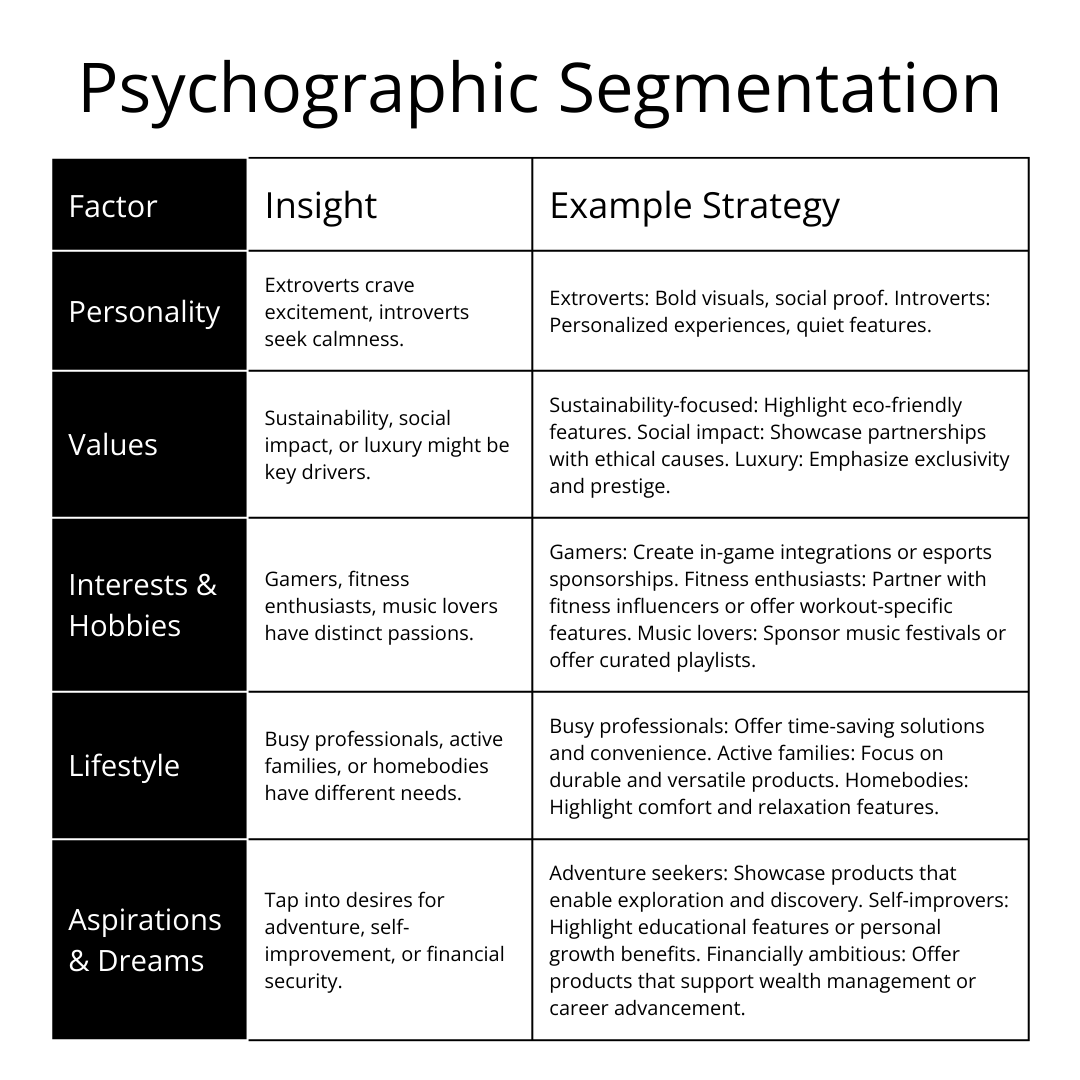
Go beyond demographics! Unlock deeper customer insights with psychographic segmentation.
Personality-Driven Strategies
Imagine you’re selling outdoor gear. Using demographics, you might target “30-40-year-olds with high income.” But psychographics can reveal more:
- The “Adventurer”: Values exploration, challenges, and pushing boundaries. Target them with technical gear and highlight exciting expeditions.
- The “Eco-Conscious”: Values sustainability and minimizing environmental impact. Showcase eco-friendly materials and responsible sourcing.
- The “Social Butterfly”: Values spending time with friends and family outdoors. Highlight gear for group activities and social gatherings.
Value Based Customer Segmentation: Connecting with Beliefs and Aspirations
What is market value-based segmentation?
Instead of simply analyzing demographics, values-based targeting delves into the beliefs, motivations, and social causes that shape your ideal customer.
This involves understanding what inspires them, what they care about, and how they see themselves in the world. By aligning your brand with these values, you create a message that resonates on a deeper, more emotional level.
Why Choose Values-Based Targeting?
- Increased Engagement: Messages that resonate with values are more likely to capture attention and spark emotional connection.
- Brand Loyalty: Consumers feel a stronger affinity for brands that share their values, fostering loyalty and repeat business.
- Enhanced Authenticity: Targeting based on shared values feels more genuine and less intrusive, building trust and credibility.
- Refined Targeting: It allows you to reach specific, high-value segments within your broader audience, optimizing your marketing spend.
Putting Values-Based Targeting into Action:
- Identify your brand’s core values: What principles guide your company and product/service?
- Research your target audience: Deep dive into their values, aspirations, and social causes through surveys, social listening, and focus groups.
- Segment your audience: Group individuals based on shared values, not just demographics.
- Craft targeted messaging: Tailor your communication to resonate with specific value segments, highlighting how your offerings align with their beliefs.
- Choose relevant channels: Select platforms and content formats frequented by your value-aligned audience.
- Measure and refine: Track results and iterate your strategy based on performance data and audience feedback.
Remember: Values-based targeting is not about creating a fake persona for your brand. It’s about authentically aligning your values with those of your audience. When done right, it fosters genuine connections, builds brand loyalty, and fuels sustainable growth
Interests and Hobbies: Reaching Passionate Communities
Why Segment by Interests & Hobbies?
Imagine tailoring your message to basketball fanatics, avid birdwatchers, or music production hobbyists. By understanding their unique interests and pain points, you can craft content and offerings that resonate on a deeper level, leading to:
- Increased engagement: Passionate communities are highly engaged, actively seeking information and connecting with others who share their interests.
- Enhanced brand loyalty: When you speak their language and address their specific needs, you build trust and become a go-to resource.
- Improved marketing ROI: Targeted campaigns are more cost-effective than scattershot approaches, maximizing your return on investment.
How to Segment Your Audience?:
- Leverage existing data: Analyze website traffic, social media interactions, and customer surveys to identify common interests and hobbies.
- Run targeted surveys: Ask specific questions about hobbies, preferred content formats, and purchase triggers.
- Utilize social listening tools: Monitor online conversations to understand community trends and pain points.
Segment Examples:
- Outdoor enthusiasts: Campers, hikers, kayakers (target gear, apparel, nature conservation initiatives).
- Foodies: Home cooks, restaurant reviewers, dietary preference groups (target recipes, cooking tools, specialized food products).
- Tech lovers: Gamers, gadget enthusiasts, early adopters (target new releases, personalized tech recommendations, workshops).
Reaching Passionate Communities:
- Create niche-specific content: Blog posts, videos, or infographics tailored to their interests and challenges.
- Engage on relevant platforms: Join online forums, participate in community events, and collaborate with influencers.
- Offer exclusive benefits: Discounts, early access, or loyalty programs designed specifically for each segment.
Remember:
- Authenticity is key: Show genuine interest in the community and avoid superficial marketing tactics.
- Be data-driven: Continuously collect feedback and adapt your approach based on results.
- Build relationships: Treat your audience like individuals, fostering meaningful connections.
Lifestyle Segmentation: Tailoring Products to Daily Routines
What is Lifestyle Segmentation?
Imagine a spectrum of diverse individuals, each with unique rhythms and priorities. Lifestyle segmentation divides this spectrum into smaller segments based on shared interests, values, activities, and aspirations. This allows you to move beyond demographics and delve deeper into the “why” behind consumer choices.
Why is it Important?
Think about it: would a fitness tracker appeal equally to a gym enthusiast and a homebody? Probably not. By understanding your target audience’s daily routines, you can develop products that seamlessly integrate into their lives. Here’s how:
- Increased Relevance: Products that resonate with daily routines feel personal and valuable. Imagine a coffee brand offering blends based on morning rituals, or a clothing line catering to specific work-from-home needs.
- Enhanced Marketing: Tailored messaging speaks directly to the aspirations and pain points of each segment. Imagine fitness ads focused on community and support for beginners while targeting experienced runners with performance data.
- Improved Customer Loyalty: When products fit seamlessly into daily routines, they become habitual. This fosters brand loyalty and encourages repeat purchases.
Putting Lifestyle Segmentation into Action:
- Define Your Target Audience: Who are you trying to reach? Are they busy professionals, active families, or budget-conscious students?
- Gather Data: Conduct surveys, analyze online behavior, and engage in customer interviews to understand their routines, aspirations, and pain points.
- Segment Your Audience: Based on your data, identify distinct groups with shared lifestyle characteristics.
- Develop Targeted Products & Messaging: Create products and messaging that address the specific needs and desires of each segment.
Lifestyle Segmentation Examples in Action:
- Meal kits: Cater to busy professionals with quick, healthy options, while offering families larger portions and kid-friendly recipes.
- Streaming services: Offer personalized recommendations based on viewing habits and interests.
- Fitness apps: Design programs tailored to different fitness goals and daily schedules.
Lifestyle segmentation isn’t just a marketing tactic; it’s a commitment to understanding your customers on a deeper level.
Aspirations and Dreams: Inspiring Customers to Achieve
Why Segment by Aspirations & Dreams?
Imagine two customers, both seeking a new laptop. One dreams of writing a captivating novel, while the other envisions launching a thriving online business. While their technical needs might overlap, their emotional motivators differ drastically.
By segmenting based on aspirations, you can:
- Craft targeted messaging: Resonate with their desires, crafting messages that speak directly to their hopes and aspirations.
- Offer personalized recommendations: Highlight features and benefits that align with their specific dreams, making the product more relevant and desirable.
- Build deeper emotional connections: Move beyond transactions and forge emotional bonds, fostering brand loyalty and advocacy.
Unlocking the Segmentation:
Now, how do you unlock this hidden treasure trove of customer aspirations? Here are some key strategies:
- Surveys and questionnaires: Design questions that delve into customers’ hopes, dreams, and what they envision achieving.
- Social media listening: Track conversations and hashtags related to aspirations and dreams relevant to your brand.
- Customer interviews and focus groups: Engage in deeper conversations to understand the emotional drivers behind their purchase decisions.
- Analyzing purchase behavior: Look for patterns in product choices that may reveal underlying aspirations (e.g., fitness equipment suggesting health goals).
Inspiring Action:
Once you’ve segmented your audience by aspirations, it’s time to ignite their journey with inspiring action:
- Showcase aspirational content: Share stories of real customers who achieved their dreams using your product, creating relatable role models.
- Offer tools and resources: Provide practical guides, workshops, or challenges that empower them to take concrete steps toward their goals.
- Recognize and celebrate milestones: Acknowledge their progress and achievements, creating a sense of community and encouragement.
- Partner with complementary brands: Collaborate with businesses that complement their aspirations, offering a broader ecosystem of support.
Remember: It’s not about manipulating dreams, but authentically aligning your brand with their aspirations. By becoming a partner in their journey, you’ll earn their trust, loyalty, and ultimately, their success story.
Behavioral Segmentation
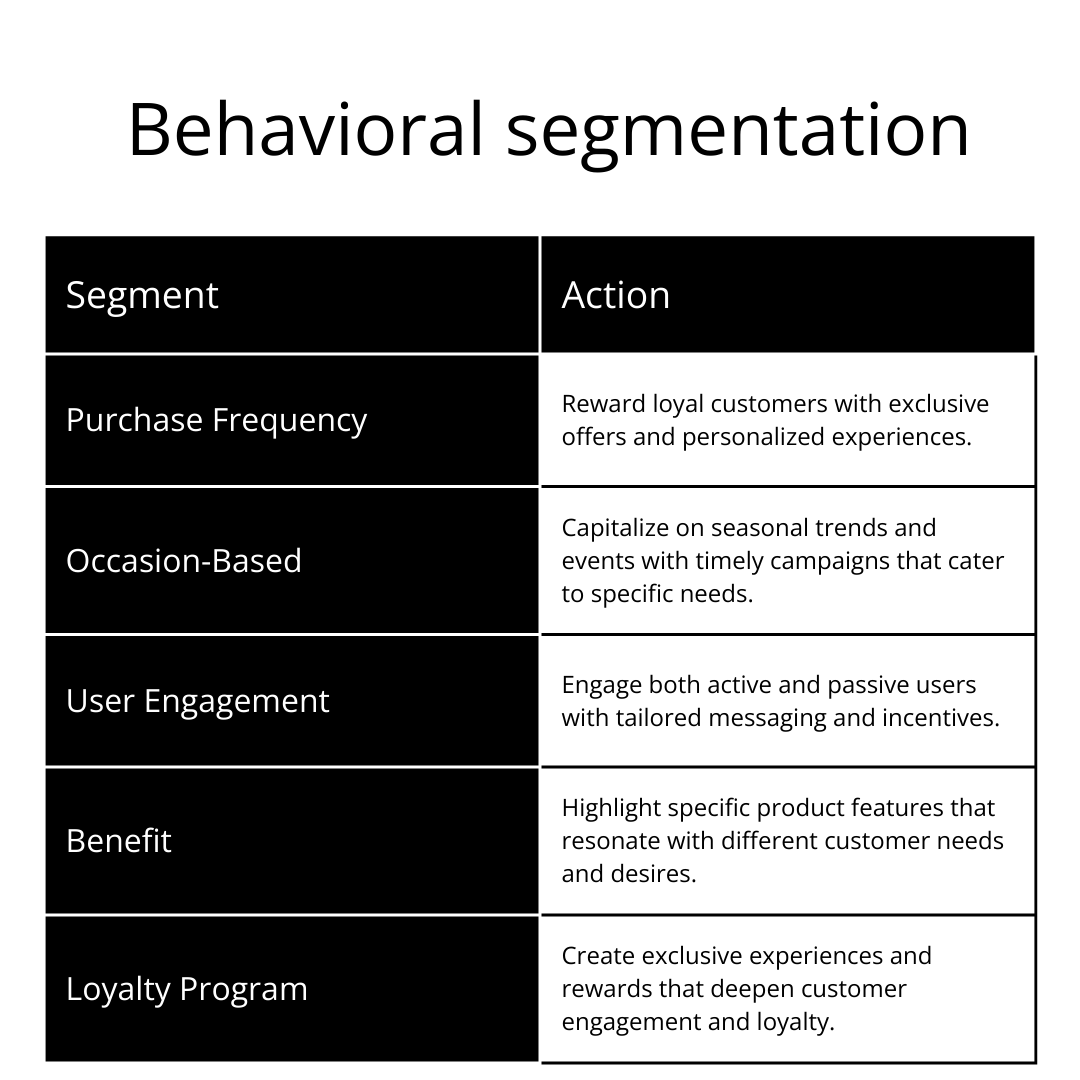
Unlock the power of customer behavior! This graphic shows how to segment your audience by purchase frequency, occasion, engagement, benefits sought, and loyalty status, and tailor your marketing accordingly.
Customer segmentation based on purchasing behavior
Why buying behavior segmentation?
Imagine crafting personalized messages for each customer, showcasing products they genuinely desire. Segmentation based on purchasing behavior makes this dream a reality. By grouping customers with similar buying patterns, you gain valuable insights into:- Needs and preferences: Understand what motivates purchases, preferred products, and spending habits within each segment.
- Engagement levels: Identify loyal customers, high-value spenders, and those at risk of churn.
- Marketing effectiveness: Tailor campaigns to resonate with specific segments, maximizing marketing ROI.
Segmenting Your Customer Base:
Now that you’re sold on the power of segmentation, how do you slice and dice your customer data? Here are some key factors to consider:
- Frequency of purchase: Are they one-time buyers, loyal regulars, or seasonal shoppers?
- Average order value: Do they splurge on high-end items or prefer budget-friendly options?
- Product category preferences: Do they gravitate towards specific product lines or dabble across the board?
- Purchase channels: Do they shop online, in-store, or through mobile apps?
- Promotional responsiveness: Are they swayed by discounts and coupons, or does brand loyalty drive their decisions?
Segmentation Tools:
Don’t fret about manually sifting through mountains of data. Leverage analytics tools and customer relationship management (CRM) software to automate the segmentation process. These tools help you identify patterns, create segments, and track their performance over time.
Why is CRM software crucial in 2024?
In today’s digital age, customers expect personalized interactions, omnichannel support, and a seamless experience across all touchpoints. CRM software empowers businesses to meet these expectations by:- Providing a 360-degree customer view: Understand your customers better, anticipate their needs, and personalize your offerings accordingly.
- Enabling omnichannel engagement: Connect with customers on their preferred channels, whether it’s email, social media, or live chat, ensuring consistent messaging and a unified experience.
- Building stronger customer relationships: Foster loyalty and advocacy by providing exceptional service and exceeding expectations.
- Optimizing marketing campaigns: Target the right audience with the right message at the right time, maximizing campaign ROI.
- Improving sales efficiency: Equip your sales team with the tools and insights they need to close deals faster and nurture leads more effectively.
Best CRM for small business
Zoho CRM Zoho packs a punch with contact management, sales pipelines, and basic reports. As your business grows, upgrade to paid plans for marketing automation and advanced analytics.
For the Collaborative Crew: Monday CRM
monday.com shines with its intuitive visual interface, making team collaboration a breeze. Drag and drop leads through sales pipelines, set automated reminders, and enjoy real-time data visibility. monday.com integrates seamlessly with popular tools like Gmail and Slack, streamlining your workflow.
For the Lead-Nurturing Ninja: Freshsales
Freshsales is a lead management powerhouse. Capture leads from multiple sources, score them based on engagement, and automate email nurturing campaigns. The built-in phone dialer and live chat features empower you to connect with leads instantly, boosting conversion rates.
For the Enterprise Ambitious: salesforce crm
Salesforce is the gold standard for CRMs, offering a comprehensive suite of features for scaling businesses. Manage complex sales processes, automate marketing campaigns, and gain deep customer insights with advanced analytics. While pricier than other options, Salesforce delivers scalability and future-proofs your CRM needs.
- Agile CRM: Best for marketing automation with a free plan.
- Apptivo: Best for complex sales funnels with customizable features.
- HubSpot CRM: Best for scaling startups with a focus on inbound marketing.
- Salesmate: Best for sales tracking with a user-friendly interface.
- Pipedrive: Best for simplicity with a visual sales pipeline.
From Insights to Action:
Segmentation is just the first step. Now, it’s time to transform those insights into action:
- Targeted marketing: Craft personalized messaging, product recommendations, and special offers tailored to each segment’s needs and preferences.
- Loyalty programs: Reward high-value customers with exclusive benefits and incentives to keep them engaged.
- Win-back campaigns: Re-engage dormant customers with targeted offers and personalized outreach.
- Product development: Use insights to inform product development, catering to specific segment preferences.
Remember, segmentation is an ongoing process. As your customer base evolves and buying habits shift, revisit your segments regularly to ensure they remain accurate and effective.Occasion Based Targeting: Capitalizing on Seasonal Needs and Events
This involves understanding consumer behavior and purchase intent around specific occasions, allowing you to deliver highly relevant and timely messages that resonate with your target audience.
Why Occasion-Based Targeting Matters:
- Increased Engagement: People are more receptive to marketing messages aligned with their current interests and needs. Occasion-based targeting leverages this, leading to higher engagement and click-through rates.
- Enhanced Brand Relevance: By demonstrating awareness of important occasions, you position your brand as relatable and attuned to your audience’s lives. This fosters brand loyalty and trust.
- Boosted Sales Conversions: Targeting consumers at the right time with the right products can significantly increase purchase intent and conversion rates.
Key Strategies for Occasion-Based Targeting:
- Identify Relevant Occasions: Consider holidays, cultural events, local celebrations, and even personal milestones like birthdays and anniversaries. Research what products or services are typically associated with each occasion.
- Utilize Audience Segmentation: Segment your audience based on demographics, interests, and past purchase behavior to personalize your messaging for different occasions.
- Craft Compelling Content: Create content that resonates with the specific occasion, using relevant keywords, visuals, and emotional triggers. Highlight how your products or services can enhance the occasion.
- Leverage Multiple Channels: Utilize a mix of channels like email marketing, social media advertising, and search engine optimization (SEO) to reach your target audience effectively.
- Track and Analyze Results: Monitor the performance of your occasion-based campaigns and adjust your strategies based on data insights.
Examples of Occasion-Based Targeting in Action:
- A sporting goods store sends targeted email campaigns with gift recommendations for Father’s Day.
- A travel agency promotes special vacation packages during peak travel seasons.
- A home decor company launches social media ads featuring festive decorations before major holidays.
Remember: Authenticity is key: Avoid being overly promotional or sales-driven. Focus on providing genuine value and connecting with your audience on an emotional level.Read also: Generate 10X More Leads in 2024
User Engagement Segmentation: Engaging Active and Passive Users
By understanding the whys behind active and passive behavior, you can craft targeted strategies to:
- Boost engagement: Re-ignite the spark for passive users and turn them into active contributors.
- Increase loyalty: Deepen the connection with active users, maximizing their lifetime value.
Unlocking Active User Potential:
- Content personalization: Tailor content to their specific interests and needs, keeping them coming back for more.
- Exclusive rewards: Offer special incentives (e.g., early access, discounts) to show appreciation and encourage continued engagement.
- Community building: Foster a sense of belonging through exclusive forums, events, or beta programs.
Rekindling the Flame for Passive Users:
- Re-engagement campaigns: Personalized emails or in-app messages reminding them of your value proposition and addressing potential pain points.
- Simplified onboarding: Ensure their initial experience is smooth and rewarding, setting them on the path to active engagement.
- Targeted value propositions: Highlight features and benefits relevant to their specific needs and usage patterns.
Remember, it’s not a one-time exercise:
- Monitor and update segments: User behavior evolves, so regularly reassess your segmentation to ensure it reflects reality.
- Measure and iterate: Track the impact of your strategies and be willing to adjust based on results.
- Test and optimize: A/B tests different approaches to find what resonates best with each segment.
Customer loyalty programs: Creating Exclusive Experiences
What is Loyalty Program Segmentation?
Imagine dividing your customer base into smaller groups based on shared characteristics, like purchase history, demographics, or interests. Each segment represents a unique “customer persona” with distinct needs and desires. Segmentation lets you tailor your loyalty program to cater to these specific preferences, creating exclusive experiences that resonate deeply with each group.
Why Segment Your Loyalty Program?
The benefits are numerous:
- Increased Engagement: Targeted rewards and experiences pique interest and encourage more frequent interactions.
- Boost in Loyalty: Feeling valued fosters deeper connections, leading to stronger brand loyalty and advocacy.
- Higher ROI: Personalized offerings resonate better, translating into increased spending and program value.
- Improved Customer Insights: Segmentation unveils valuable data about customer preferences, informing future strategies.
Crafting Exclusive Experiences:
Now, let’s delve into the exciting part: designing exclusive experiences for each segment. Here are some ideas:
- For High-Value Customers: Offer early access to sales, personalized product recommendations, exclusive invitations to events, or VIP customer service experiences.
- For Frequent Buyers: Reward them with bonus points on specific categories, accelerated point redemption, or free shipping perks.
- For New Customers: Design welcome rewards, personalized product samples, or early access to new product launches.
- For Inactive Customers: Re-engage them with targeted offers, bonus point multipliers, or special discounts on their preferred products.
Remember: Data is Key – leverage customer data to understand your segments and personalize their experiences effectively.Firmographic Segmentation for SMBs
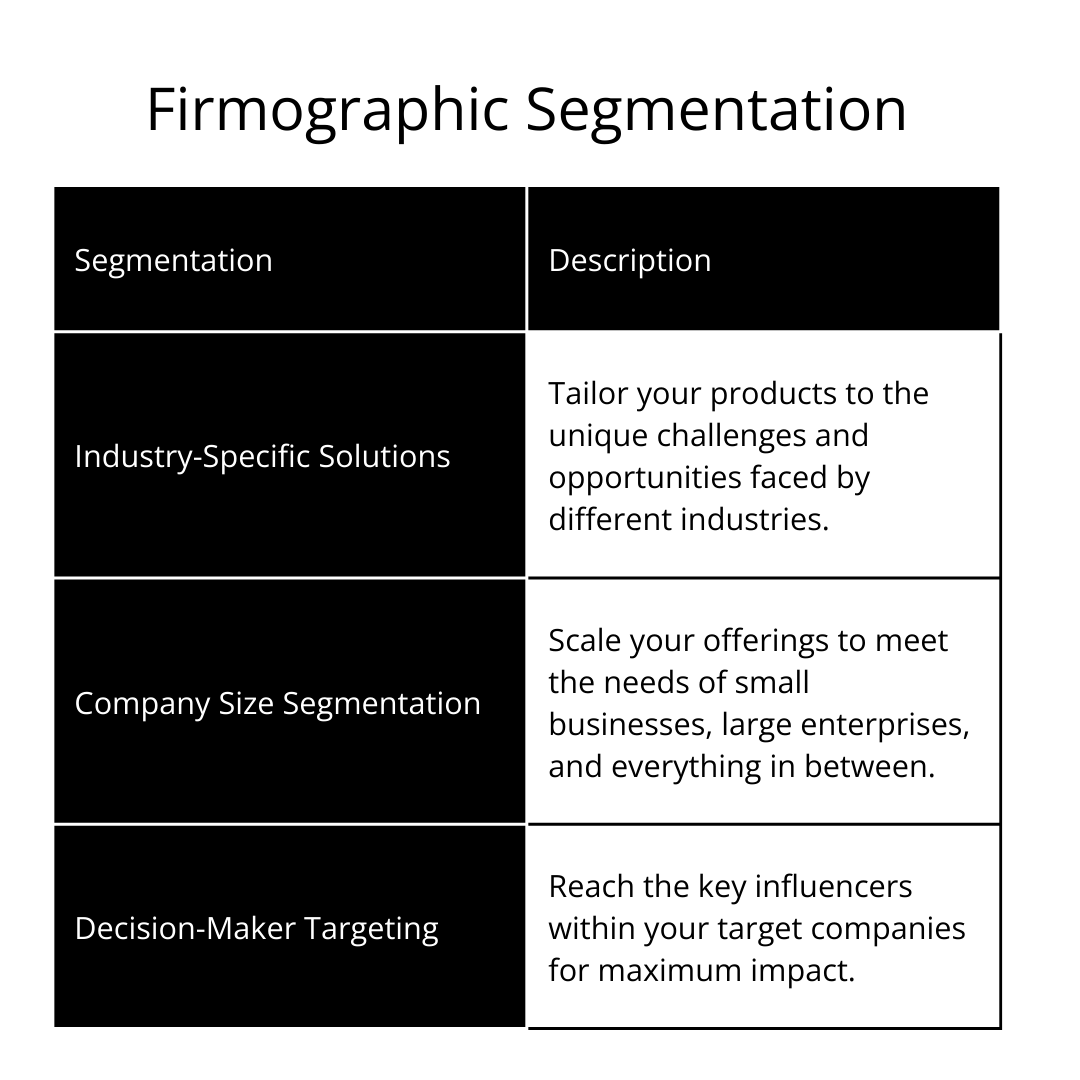
Segmenting your B2B audience for success: Industry, size, and decision-makers.
1. Industry-Specific Solutions: Tailoring Products to Specific Challenges
Different industries face unique pain points and opportunities. By segmenting your audience by industry, you can develop solutions and messaging that directly address their specific challenges. This allows you to demonstrate a deeper understanding of their needs, building trust and credibility.
For example, a cybersecurity solution provider could offer different packages for healthcare organizations (focusing on patient data protection) compared to financial institutions (emphasizing fraud prevention).
2. Company Size Segmentation: small and medium businesses
Small and medium-sized businesses (SMBs) have different needs and budgets compared to large enterprises. By segmenting your audience by company size, you can tailor your offerings and pricing to resonate with each segment. SMBs might prefer subscription-based models with simple implementations, while larger enterprises might be looking for customized solutions and integrations.
3. Decision-Maker Targeting: Reaching the Influencers
Identifying the key decision-makers within each target segment is crucial for B2B success. By analyzing firmographic data like job titles and buying behaviors, you can pinpoint the individuals who have the power to influence purchase decisions. This allows you to personalize your outreach and messaging, increasing your chances of conversion.
Beyond these three key areas, firmographic segmentation can also help you:
- Improve lead generation: Target specific industries and company sizes with high potential for your product or service.
- Increase marketing ROI: Allocate your resources more effectively by focusing on the segments with the highest conversion potential.
- Personalize your sales approach: Tailor your sales pitches and presentations to resonate with each decision-maker.
This allows you to build stronger relationships, understand customer needs, and ultimately, drive more successful B2B sales.
